Review Qumo Go!
On the wave of interest in tablets, I want to present an overview of a cheap ($ 250) device from the already well-known Qumo brand - Qumo Go! .. Go! The first Android tablet of the company, but in fact, is one of a huge number of devices built on the basis of the popular SoC Telechips 8900 (8902 according to the manufacturer).
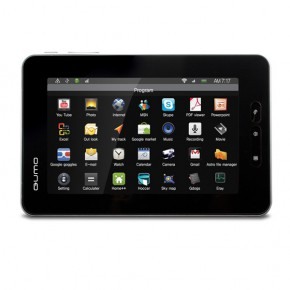
So, let's start with a brief description of the device (the full specification can be found on the manufacturer's website ):
')
The tablet comes in a good, rigid cardboard box of a cheerful green color, on which (in Russian) the manufacturer and device name, brief technical characteristics are indicated and for what it can be used, the package bundle. Inside the package we will find a rather impressive set, which consists in addition to the MID from:
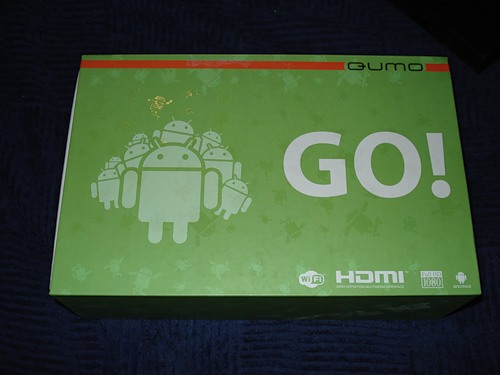

The quick start guide is really short:
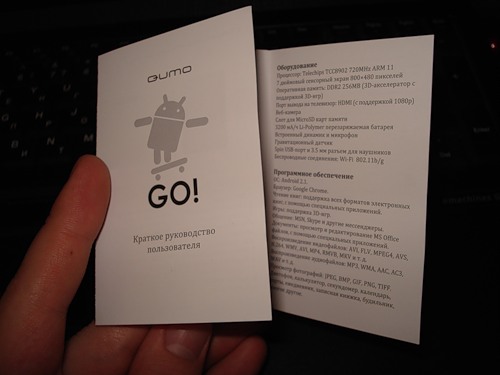
At this stage, the claim was caused only by the cover - the indescribable smell of Chinese haberdashery and a strange design feature, which is that its most rigid part is under the back cover of the device, which is already aluminum, and the part that covers the screen itself is less hard. However, the tablet is well "sitting" in the case and take it out is not so easy. There is no HDMI cable in the standard package, but this is predictable. Headphones just are - and that's good.
The appearance of the tablet was clearly influenced by the iPad - it is pointless to deny it, but another form factor for devices like “big touch screen and frame” has not yet been invented. When you take the device in hand for the first time, it seems that it is very stretched - the aspect ratio contributes to that. The frame around the screen is large enough, because holding the tablet with one hand, and the second to type the text quite comfortably. The weight of the device (400 g) - also within the comfort limits - is not very heavy and not very light. On the front panel are three standard for Android devices menu buttons, return to the home screen and "back." The front panel is plastic, the screen is covered with a protective film, the back panel is aluminum. Here the first defect appeared - in the middle of the side frames on the longer side there is a slight backlash and creaking when the frame plastic is pressed by the finger when you take the device in your hands. The protective film flickers very well, so in bright light it will be difficult to work with the tablet. At the upper end of the case there is a headphone jack, at the bottom there is a speaker grille, a 2.5 connector for the power adapter, two USB connectors, an SD card slot and an HDMI connector. On the right side there is a power button and volume rocker, plastic buttons. The case is not very hard, despite the aluminum back cover, but on the whole it is quite reliable and well assembled (not counting the said backlash of the frame). And now a little photo:
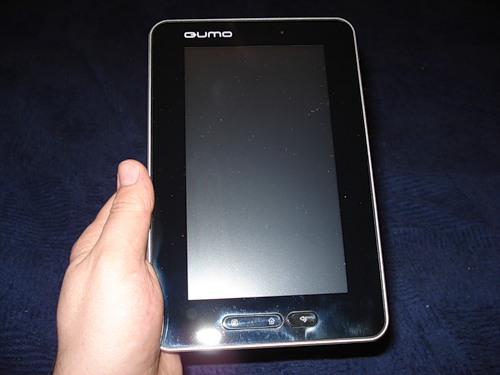
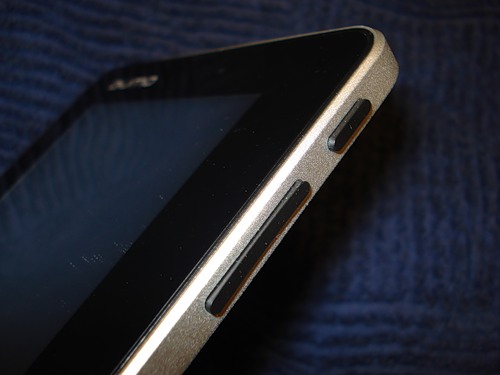
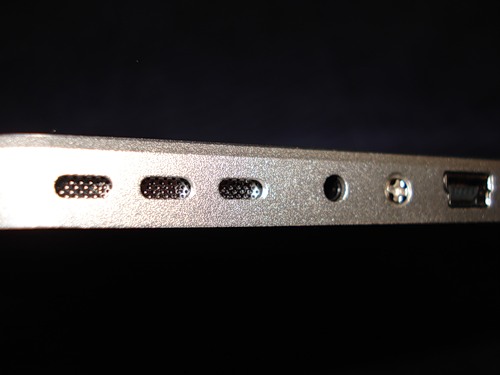

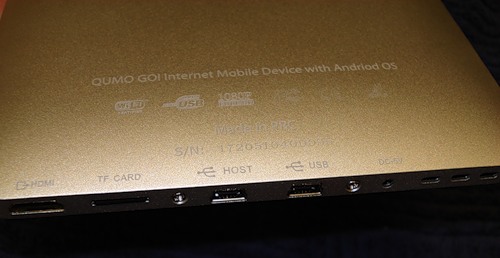
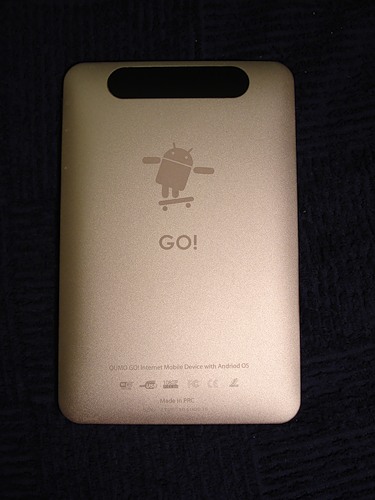
The launch of the device in my opinion is quite long - about one minute before the desktop and then another thirty seconds before the device starts to respond to external stimuli, i.e. on user actions. While there is a launch, you can watch a fun droid on a skateboard, something like this:

After the robot rolls on a skateboard, we’ll see the standard Android OS desktop without any customizations, enhancements, and so on. And after a few seconds, it becomes clear where (with HDMI, 8GB of internal memory, camera, etc.) such an attractive price came from. Screen. On the screen, the manufacturer clearly decided to save - dull colors, a poor palette, and perhaps the most lousy - the wrong proportions of objects, which can be seen very well on round objects that become slightly elongated along the long side of the screen. This screen is for text and for movies, photos are not very comfortable to watch (although funny effects are sometimes obtained). Also, a sufficiently large grain does not contribute to a good display of fine print.
What comes in the basic delivery of software? In addition to standard applications such as browser, mail, maps and other things, the bundle includes: Android Market, App Installer and App Monster, Advanced Task Killer Free and a fairly good ES file manager that can navigate SMB, FTP, has a built-in viewer and much more. . The interface is localized, but for some reason the Russian keyboard is missing - I had to immediately install it from the market. However, there are other roughness, for example, "The phone will be disconnected" a little alarming and frustrating. But the fact that almost all 8GB of internal memory is given at the root of the file system is good news - even though the OS version is 2.1 and there is no app2sd. User files are in / nand - photos, music, documents, and more.
The device copes with the playback of videos on YouTube and DVD-Rip'ami, but with audio so far weird - when playing background music and surfing the Internet when you open a new tab or click on the link, sometimes playback starts to "stutter", as if not enough processor resources. The sound quality through the headphones (not from the kit) is quite decent, the sound of the speaker ... well, it will be heard, without rattling, but you cannot talk about quality.
When the device is connected to the computer, the user folder / nand becomes available as the carrier. The USB host works well, the inserted USB flash drive was determined automatically, and then it became available in the file manager along the / scsi path, but the disconnection required access to the settings. Of course, you don’t need to think about connecting external hard drives, but connecting a camera is fine, especially since the tablet quickly enough copes with scaling large images.
No problem with the wireless connection.
The large available disk space prompts you to put a lot of all sorts of games and other things, but here I was waiting for the second big bummer after the screen - Angry Birds. Something you can play in Rio, in the other versions is absolutely impossible, and not even because of the “brakes”, but because of the strange problems with animation textures and sprites. Most of the usual programs are installed without any problems. I installed the client for twitter, facebook, calculator, Google Skymap, client Popular Mechanics, DropBox, SugarSync and something else. And then the funny problems started with DropBox and SugarSync. The first one seemed to be working, but it was absolutely impossible to open the downloaded files, for it was not clear where he downloaded them, and the second one refused to work at all and crashed on launch. It turned out that even though we have a few gigabytes of internal space, we still need to have at least a small SD card. And Google Reader enters an endless loop of synchronization and it is not possible to use it. Skype - I had to install the Lite version, because I didn’t want to work. How now to apply the front camera - a mystery.
Then the most amusing glitches with the G-sensor surfaced. Some applications (RealCalc and the client of Popular Mechanics) that do not support screen flipping are launched upside down by 180 degrees, while Skymap is constantly constantly rotated by 90 and cannot keep up with it. I suspect that the sensor is incorrectly calibrated or there is some error in its settings. Yes, and of course you can turn off his (G-sensor).
Overall, even if there is a market with software, certain problems arise, and I would write most of them to the software part, i.e. on the OS / firmware itself.
So far, I have ambivalent impressions about Qumo Go! .. On the one hand, there is a fairly high-quality assembly, good technical characteristics (for such a price), local service and a guarantee, unlike nouneyms from China. On the other hand, there is a bad screen, firmware bugs and software problems. I have this second Qumo device - the first is the Libro "reader" - and by the way software updates are being actively developed and released, I hope that at least the software problems will be fixed in future firmware and the manufacturer will not forget about its customers. It seems like there are rumors that for Go! An update to 2.3 is being prepared, but for now - for the most part, the tablet serves as a youtube player, a music player and a mail-tweeter aggregator (in fact, it was purchased for this). For those who are thinking about purchasing this or similar device with an attractive price - think about whether you are ready for possible problems and, most importantly, if you are ready to solve them. ;)

So, let's start with a brief description of the device (the full specification can be found on the manufacturer's website ):
- CPU : ARM v11 720MHz
- RAM : DDR2 256 Mb
- Internal memory : Nand 8Gb + slot for SD-cards (up to 32Gb)
- Screen : 7 ", resistive, 800x480 pixels
- Network interfaces : 809.11 b / g
- Other interfaces : USB, USB-Host, HDMI, 3.5 mm headphone, 0.3 megapixel camera, microphone, speaker
- Add. features : G-sensor
- OS : Android 2.1
')
Packing and packaging
The tablet comes in a good, rigid cardboard box of a cheerful green color, on which (in Russian) the manufacturer and device name, brief technical characteristics are indicated and for what it can be used, the package bundle. Inside the package we will find a rather impressive set, which consists in addition to the MID from:
- Hard case book
- Charger
- Usb cable
- Usb host cable
- USB-to-2.5DC charging cable (yes, there is such a connector)
- Headphones
- Quick Start Guide
- Warranty card


The quick start guide is really short:

At this stage, the claim was caused only by the cover - the indescribable smell of Chinese haberdashery and a strange design feature, which is that its most rigid part is under the back cover of the device, which is already aluminum, and the part that covers the screen itself is less hard. However, the tablet is well "sitting" in the case and take it out is not so easy. There is no HDMI cable in the standard package, but this is predictable. Headphones just are - and that's good.
Appearance, build quality
The appearance of the tablet was clearly influenced by the iPad - it is pointless to deny it, but another form factor for devices like “big touch screen and frame” has not yet been invented. When you take the device in hand for the first time, it seems that it is very stretched - the aspect ratio contributes to that. The frame around the screen is large enough, because holding the tablet with one hand, and the second to type the text quite comfortably. The weight of the device (400 g) - also within the comfort limits - is not very heavy and not very light. On the front panel are three standard for Android devices menu buttons, return to the home screen and "back." The front panel is plastic, the screen is covered with a protective film, the back panel is aluminum. Here the first defect appeared - in the middle of the side frames on the longer side there is a slight backlash and creaking when the frame plastic is pressed by the finger when you take the device in your hands. The protective film flickers very well, so in bright light it will be difficult to work with the tablet. At the upper end of the case there is a headphone jack, at the bottom there is a speaker grille, a 2.5 connector for the power adapter, two USB connectors, an SD card slot and an HDMI connector. On the right side there is a power button and volume rocker, plastic buttons. The case is not very hard, despite the aluminum back cover, but on the whole it is quite reliable and well assembled (not counting the said backlash of the frame). And now a little photo:






Power on, basic software and first impressions
The launch of the device in my opinion is quite long - about one minute before the desktop and then another thirty seconds before the device starts to respond to external stimuli, i.e. on user actions. While there is a launch, you can watch a fun droid on a skateboard, something like this:

After the robot rolls on a skateboard, we’ll see the standard Android OS desktop without any customizations, enhancements, and so on. And after a few seconds, it becomes clear where (with HDMI, 8GB of internal memory, camera, etc.) such an attractive price came from. Screen. On the screen, the manufacturer clearly decided to save - dull colors, a poor palette, and perhaps the most lousy - the wrong proportions of objects, which can be seen very well on round objects that become slightly elongated along the long side of the screen. This screen is for text and for movies, photos are not very comfortable to watch (although funny effects are sometimes obtained). Also, a sufficiently large grain does not contribute to a good display of fine print.
What comes in the basic delivery of software? In addition to standard applications such as browser, mail, maps and other things, the bundle includes: Android Market, App Installer and App Monster, Advanced Task Killer Free and a fairly good ES file manager that can navigate SMB, FTP, has a built-in viewer and much more. . The interface is localized, but for some reason the Russian keyboard is missing - I had to immediately install it from the market. However, there are other roughness, for example, "The phone will be disconnected" a little alarming and frustrating. But the fact that almost all 8GB of internal memory is given at the root of the file system is good news - even though the OS version is 2.1 and there is no app2sd. User files are in / nand - photos, music, documents, and more.
The device copes with the playback of videos on YouTube and DVD-Rip'ami, but with audio so far weird - when playing background music and surfing the Internet when you open a new tab or click on the link, sometimes playback starts to "stutter", as if not enough processor resources. The sound quality through the headphones (not from the kit) is quite decent, the sound of the speaker ... well, it will be heard, without rattling, but you cannot talk about quality.
When the device is connected to the computer, the user folder / nand becomes available as the carrier. The USB host works well, the inserted USB flash drive was determined automatically, and then it became available in the file manager along the / scsi path, but the disconnection required access to the settings. Of course, you don’t need to think about connecting external hard drives, but connecting a camera is fine, especially since the tablet quickly enough copes with scaling large images.
No problem with the wireless connection.
We install additional software
The large available disk space prompts you to put a lot of all sorts of games and other things, but here I was waiting for the second big bummer after the screen - Angry Birds. Something you can play in Rio, in the other versions is absolutely impossible, and not even because of the “brakes”, but because of the strange problems with animation textures and sprites. Most of the usual programs are installed without any problems. I installed the client for twitter, facebook, calculator, Google Skymap, client Popular Mechanics, DropBox, SugarSync and something else. And then the funny problems started with DropBox and SugarSync. The first one seemed to be working, but it was absolutely impossible to open the downloaded files, for it was not clear where he downloaded them, and the second one refused to work at all and crashed on launch. It turned out that even though we have a few gigabytes of internal space, we still need to have at least a small SD card. And Google Reader enters an endless loop of synchronization and it is not possible to use it. Skype - I had to install the Lite version, because I didn’t want to work. How now to apply the front camera - a mystery.
Then the most amusing glitches with the G-sensor surfaced. Some applications (RealCalc and the client of Popular Mechanics) that do not support screen flipping are launched upside down by 180 degrees, while Skymap is constantly constantly rotated by 90 and cannot keep up with it. I suspect that the sensor is incorrectly calibrated or there is some error in its settings. Yes, and of course you can turn off his (G-sensor).
Overall, even if there is a market with software, certain problems arise, and I would write most of them to the software part, i.e. on the OS / firmware itself.
As a conclusion
So far, I have ambivalent impressions about Qumo Go! .. On the one hand, there is a fairly high-quality assembly, good technical characteristics (for such a price), local service and a guarantee, unlike nouneyms from China. On the other hand, there is a bad screen, firmware bugs and software problems. I have this second Qumo device - the first is the Libro "reader" - and by the way software updates are being actively developed and released, I hope that at least the software problems will be fixed in future firmware and the manufacturer will not forget about its customers. It seems like there are rumors that for Go! An update to 2.3 is being prepared, but for now - for the most part, the tablet serves as a youtube player, a music player and a mail-tweeter aggregator (in fact, it was purchased for this). For those who are thinking about purchasing this or similar device with an attractive price - think about whether you are ready for possible problems and, most importantly, if you are ready to solve them. ;)
Source: https://habr.com/ru/post/117372/
All Articles